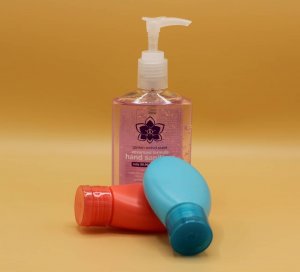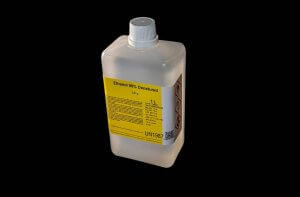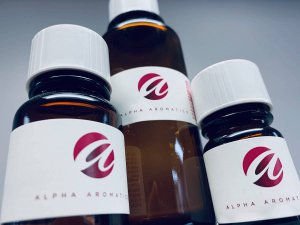Covid-19 presents many challenges to a frightened populace who has not for more than a century (1918 Spanish Flu) experienced the dread associated with a contagious virus that knows neither cure nor vaccine.
The only weapons experts promote so far are preventive measures, such as social distancing, wearing masks and washing hands with hand sanitizer, which has caused a dire shortage of the supply of the ingredient, isopropanol.
In the early stages of the pandemic, isopropanol, which is also known as isopropyl alcohol, rubbing alcohol and IPA, became very difficult to obtain and very costly.

Consequently, manufacturers turned to ethanol in its stead, but until our perfume masters at Alpha Aromatics addressed its stinky smell with the development of new fragrance additives, this was an issue solved only by expensive carbon filtration systems, which require a great deal of time and effort to install.
Its offensive odor is the result of the manner in which the ethanol is produced, and can range from a very malodorous rotting garbage smell to tequila, fermented corn or an herbal spirit, all of which are undesirable for hand-sanitizers.
In fact, the New York Times wrote about our odor control solutions for ethanol-based sanitizers.
Isopropyl alcohol has recently become more available and prices have come down due to the simple economic principle of supply and demand, and while ethanol is still in use by some, many more fragrance formulators are now developing fragrances that utilize isopropyl alcohol for use in hand sanitizers.
These products fall into two groups: alcohol-based, which are more common; and those that contain no alcohol. The most commonly used hand sanitizers featuring alcohol are made from either isopropyl alcohol or a form of denatured ethanol, normally at a 70% concentration.

A Brief History of Isopropanol Alcohol
IPA was the first commercial synthetic alcohol created by chemists at the Standard Oil Company of New Jersey (later Exxon Mobil) back in 1920 while studying petroleum oil products.
Its major use at that time was not rubbing alcohol, but oxidation to acetone, which was first used in World War I for the preparation of cordite, a smokeless, slow burning fuel composed of 30 to 58 percent nitroglycerin, 37 to 65 percent nitrocellulose and 5 to 6 percent mineral jelly.
Today, IPA is the most widely used disinfectant within the pharmaceutical, hospital, electronics and medical device manufacturing industries, and is often used as a solvent. Although it retains a tell-tale odor, it is nowhere near as bad as ethanol.
Isopropanol vs Ethanol
Hand sanitizers must contain 60% to 62% alcohol for ethanol or 70% alcohol for isopropanol in order to be effective tools in the arsenal against the corona virus. Both of these compounds destroy microorganisms by penetrating cell walls, damaging membranes, and destroying the properties of proteins.
Ethanol may be used in purely surface-cleaning applications. For disinfecting surfaces, ethanol and isopropyl alcohol are nearly equally efficient. As disinfectants, both are typically at a concentration of 70 percent in water. Ethanol, however, cannot be utilized in higher concentrations because it evaporates too quickly and isn’t as effective in lower amounts.
Discover how our scents complete the mission of surface cleaning disinfectant brands!

Both ethanol and isopropanol are capable of dissolving lipids, which makes them effective against lipid-wrapped viral cells, such as HIV and hepatitis. The two evaporate at a similar rate and destroy bacterial and viral cells by the same mechanism, but because isopropyl alcohol is not as effective at dehydrating living tissue, it is a better solution for disinfecting skin than ethanol.
They are also both relatively inexpensive and easy to handle, although their vapors can be flammable. The difference is that IPA can also double as antiseptic and is often used in hospitals for this purpose. Also, the two vary in effect when rubbed onto the skin.
Manufacturers deliberately denature ethanol as a means to avoid the costly excise tax associate with drinkable ethanol. Foul tasting chemicals (denaturants) such as: methanol; pyridine, isopropyl; alcohol; acetone; methyl ethyl ketone; methyl isobutyl ketone and denatonium combine to render ethanol undrinkable.
In addition, ethanol’s offensive odor is at least in part, the result of the fact that it is derived from natural products such as: corn, wheat, grain sorghum, barley, potatoes, sugar cane and sweet sorghum.
Alpha Aromatics and Our Fragrance Solutions
Our perfume masters at Alpha Aromatics continually work to meet the dynamic global needs of manufacturers from a vast array of industries. Family-run and with routes stretching back to the aftermath of World War II, we are pioneers within the perfume industry.

Our continued success is no accident. We invest heavily in the most innovative scientific tools, and the laboratories in their expansive 85,000-square foot Technology Center, which is situated in suburban Pittsburgh, has the most innovative, cutting edge equipment known to industrial science. Some of these include: gas chromatography, mass spectrometry, head-space analysis, distillation, extraction and quality control technology.
Our technologies are and always have been sustainable, and reflect a love and respect for planet Earth. Our carbon footprint has always been a major concern of ours, even long before sustainability became fashionable and politically correct. We are bound by strict ethics and regulatory standards, including those outlined by ISO (the International Organization for Standardization), RIFM, IFRA, Oregon Tilth, the National Products Association and ISSA.
A Dedicated Fragrance Line For Isopropanol Sanitizers
In addition to fine fragrances, we also offer the world’s most efficient and effective options for odor-control additives, and today we have undertaken the gargantuan task of harnessing all our skills to help combat Covid-19 by successfully reducing offensive odors and providing isopropyl alcohol-based hand sanitizers with a pleasant scent to a fearful population.

After much research and laboratory experimentation, our research teams at Alpha Aromatics team have developed a dedicated line of fragrances, which effectively work to reduce the sharp and musty odor of alcohol in hand sanitizers that are made from isopropyl alcohol.
Tea Leaves
Bursts of sour sweet lemon and succulent orange form the top notes of this intriguing fragrance. These elements soon surrender to a heart note comprised of minty, fresh and sharp eucalyptus, gingery, intense lemongrass and deeply aromatic and savory tea leaf.
The scent completes with a bottom note featuring aspects of rich, warm amber, woody and dry cedar wood, creamy, slightly powdery sandalwood and sensual musk.
Citrus Blossom
This fragrance opens with a citrusy/fruity top note characterized by sweet, succulent clementine, green, inviting apple, tangy and slightly woody raspberry and tart, uplifting grapefruit.
A heart note soon follows featuring refreshing, floral and spicy freesia, sweet, dusty violet and fresh, honeyed orange blossom. A base note characterized by warm rich amber and sensual musk completes the scent.
Applewood
Top notes of crisp apple, sour sweet lemon and piquant red berries soon blend into a middle note marked by sharp and savory camphor, peppery, zesty spices and balsamic and woody pine. The scent finalizes with a base note containing elements of rich and earthy amber, sensual and passionate musk and dry woody and green aged oak.
Cucumber
A rush of invigorating citrus, crisp and green apple and fresh clean, cucumber comprise the top notes of this fruity/floral fragrance. These aspects give way to a heart note of intoxicating and haunting jasmine, sugary, powdery violet and luminous, exotic lily. A leafy green and woody base note completes this alluring scent.
In Conclusion
Who can say how long Covid-19 will remain a threat to human life and health? Hopefully, one day soon it will all be a bad memory dimly recalled.
Whatever the answer, the need for hand sanitizers to help protect populations from common flus and other bacteria and viruses will always remain.
And as long as that need remains, we too will always be looking out for our customers and insuring that we provide the best we can offer to them both in good times and in bad.
If you are a company seeking new fragrances for hand-sanitizers, send us a message or call our team today! We’re here to help — +1-412-252-1012.
What Fragrances Work Best With Isopropyl Hand Sanitizers?
Certain fragrances are more effective in masking the odors associated with Isopropanol alcohol, or IPA, when used within hand sanitizing products. In our experience, the following blends effectively mask these odors: Tea Leaves, Citrus Blossom, Applewood and Cucumber.
Photo Credits: Pixabay
 alpha aromatics®
alpha aromatics®